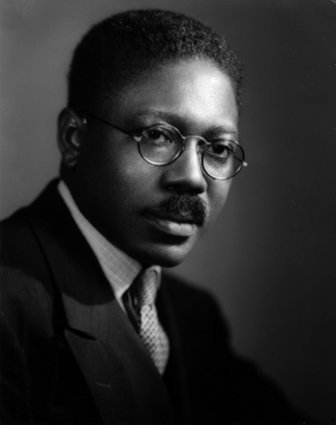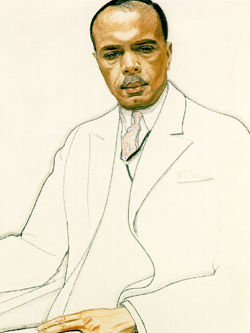
Lois Mailou Jones was born on November 3, 1905. She was a prize winning artist who lived until her nineties and who painted and influenced others during the Harlem Renaissance and beyond during her long teaching career. She started painting at a young age, fell in love, and had a passion for it her whole life. She attended the School of the Museum of Fine Art, Boston, at a time when racial prejudice and discrimination were omnipresent features of American life. Jones engineered her professional art career in spite of barriers. Despite these trials, Jones prevailed on the basis of her talent, energy, and persistence. She refused to be discouraged. After graduation, she was hired by Charlotte Hawkins Brown after some initial reservations and founded the art department at Palmer Memorial Institute in North Carolina. Only one year later, she was recruited to join the art department at Howard University in Washington D.C and remained as professor of design and watercolor painting until her retirement in 1977. In 1927, she was awarded a diploma in Design with honors and went on to do graduate studies at prestigious schools in the U.S. and France. She received her bachelor’s degree from Howard University in 1945, graduating magna cum laude, and an Honorary Doctorate of Humane Letters from Suffolk University in Boston. She also has received honorary degrees from Colorado State Christian University, Massachusetts College of Art, and Howard University and was elected Fellow of The Royal Society of Arts in London. In 1937, for her first sabbatical from Howard University on a general educational fellowship, she went to Paris for the first time where she worked very hard producing 35 to 40 pieces during one year’s time, including "Les Fetiches" a stunning, African inspired oil which is owned by the Smithsonian American Art Museum and one of her best known works and her first piece which combined traditional African forms with Western techniques and materials to create a vibrant and compelling work. She married Haitian artist Louis Vergniaud Pierre-Noel in 1953. She then traveled and lived in Haiti. In 1980, she was honored by President Jimmy Carter at the White House for outstanding achievements in the arts. Her paintings grace the permanent collections of the Metropolitan Museum of Art, National Museum of American Art, Hirshhorn Museum and Sculpture Garden, National Portrait Gallery, Boston Museum of Fine Arts, the National Palace in Haiti, and the National Museum of Afro-American Artists and many others. In her nineties, Jones still painted. Bill Clinton and Hillary Clinton collected one of her island seascapes "Breezy Day at Gay Head" while they were in the White House. Lois felt that her greatest contribution to the art world was "proof of the talent of black artists. Jones died June 9, 1998, and her friends and colleagues wrote a book about her entitled Lois Mailou Jones: a life in color. Her work is in museums all over the world and valued by collectors. From November 14, 2009 to February 29, 2010, a retrospective exhibit of her work entitled "Lois Mailou Jones: a life in vibrant color" will be held at the Mint Museum of Art in Charlotte, NC. The exhibit will include 70 paintings showcasing her various styles and experiences: America, France, Haiti, and Africa.

Born on January 15, 1890, Palmer Hayden’s original name was Peyton Cole Hedgeman. He was given the name Palmer Hayden by his commanding sergeant during World War I. He grew up in the town of Wide Water, Virginia, and was a so-called self trained artist. Hayden was one of the first in America to depict African subjects in his paintings. Though he had shown some talent for making pictures as a child, he received his first formal art training while in the military, enrolling in a correspondence course in drawing. He settled in New York after the war. The year was 1919, and the city's black community was in the midst of a remarkable cultural movement that saw new developments in literature, drama, music, and the visual arts. As a young man, Hayden studied at the Cooper Union in New York City and also practiced independent studies at Boothbay Art Colony in Maine. Hayden took his inspiration from the environment around him, focusing on the African American experience. He tried to capture both rural life in the South, as well as urban backgrounds in New York City. Many of these urban paintings were centered in Harlem. He created one of his first famous pieces in 1926: a still life called Fetiche et Fleurs(Fetish and Flowers), which won the esteemed Harmon Foundation’s Gold Award. After receiving this award, supportive patrons granted Hayden money to study in France. He went to Paris for a while and on his return to America, Hayden began working for the United States government. He worked for the U.S. Treasury Art Project as well as the Depression-era government-funded Works Progress Administration (WPA). He died on February 18,1973, at the age of 83.

Aaron Douglas was the Harlem Renaissance artist whose work best exemplified the 'New Negro' philosophy. Douglas was born May 26, 1899, in Topeka, Kansas. He developed an interest in art during his childhood and was encouraged in his pursuits by his mother. Douglas graduated from Topeka High School in 1917. He received his B.A. degree from the University of Nebraska-Lincoln in 1922. In 1925, Douglas moved to New York City, settling in Harlem to pursue art. Just a few months after his arrival he began to produce illustrations for both The Crisis and Opportunity, the two most important magazines associated with the Harlem Renaissance. He also began studying with Winold Reiss, a German artist who had been hired by Alain Locke to illustrate The New Negro. Reiss's teaching helped Douglas develop the modernist style he would employ for the next decade. Douglas’s engagement with African and Egyptian design brought him to the attention of W. E. B. DuBois and Alain Locke, who were pressing for young African American artists to express their African heritage and African American folk culture in their art. For the next several years, Douglas was an important part of the circle of artists and writers we now call the Harlem Renaissance. In addition to his magazine illustrations for the two most important African-American magazines of the period, he illustrated books, painted canvases and murals, and tried to start a new magazine showcasing the work of younger artists and writers. Douglas looked for opportunities to increase his knowledge about art. In 1928-29, Douglas studied African and Modern European art at the Barnes Foundation in Merion, Pennsylvania on a grant from the foundation. It was during the early 1930s that Douglas completed the most important works of his career, his murals at Fisk University and at the 135th Street Branch of the New York Public Library (now the Arthur Schomburg Center for Research in Black Culture). In 1931 he traveled to Paris, where he spent a year studying more traditional French painting and drawing techniques at the Academie Scandinavia In 1937, he moved to Nashville, Tennessee, where he founded the Art Department at Fisk University and taught for 29 years. He died Feb. 2, 1979, in Nashville, TN, of a pulmonary embolism.

Jacob Lawrence was born September 7, 1917 in Atlantic City, New Jersey. He was an African American painter who referred to his style as "dynamic cubism". Lawrence was thirteen when he moved with his mother, sister and brother to New York City. His mother enrolled him in classes at an arts and crafts settlement house in Harlem, in an effort to keep him busy. After dropping out of high school at sixteen, Lawrence worked in a laundry and a printing plant. More importantly, he attended classes at the Harlem Art Workshop, taught by his mentor, the African American artist Charles Alston. Alston urged him to also attend the Harlem Community Art Center, led by the sculptor Augusta Savage. Savage was able to secure Lawrence a scholarship to the American Artists School and a paid position with the Works Progress Administration. In addition to getting paid, he was able to study and work with such notable Harlem Renaissance artists as Alston and Henry Bannarn in the Alston-Bannarn workshop. Lawrence was only in his twenties when his "Migration Series" made him nationally famous. The series of paintings was featured in a 1941 issue of Fortune magazine. The series depicted the epic Great Migration of African Americans from the rural South to the urban North. In the 1940s Lawrence was given his first major solo exhibition at the Museum of Modern Art in New York City, and became the most celebrated African American painter in the country. Lawrence married the painter Gwendolyn Knight, who had also been a student of Savage's, on July 24, 1941. They remained married until his death in 2000. In November 1943, during the Second World War, he enlisted in the United States Coast Guard, then part of the United States Navy.He was able to paint and sketch while in the Coast Guard, and travelled to Egypt, Italy and India. In 1970 Lawrence settled in Seattle, Washington and became an art professor at the University of Washington. Shortly after moving to Washington State, Lawrence did a series of five paintings on the westward journey of African American pioneer George Washington Bush. These paintings are now in the collection of the State of Washington History Museum.[3] Lawrence was honored as an artist, teacher, and humanitarian when the NAACP awarded him the Spingarn Medal in 1970 for his outstanding achievements. In 1974 the Whitney Museum of American Art in New York held a major retrospective of his work, and in 1983 he was elected to the American Academy of Arts and Letters. In 1998 he received Washington State's highest honor, The Washington Medal of Merit. He was awarded the U.S. National Medal of the Arts in 1990. When Lawrence died on June 9, 2000, the New York Times called him "one of America's leading modern figurative painters" and "among the most impassioned visual chroniclers of the African-American experience.[8]" His wife, artist Gwendolyn Knight Lawrence, died several years later in 2005. In the wake of their passing, the Jacob and Gwendolyn Knight Lawrence Foundation was formally established. Throughout his lengthy artistic career, Lawrence concentrated on depicting the history and struggles of African Americans. Lawrence's work often portrayed important periods in African-American history. Some of his works are now displayed there in the Paul G. Allen Center for Computer Science & Engineering and in Meany Hall for the Performing Arts. Lawrence is among the best-known twentieth century African American painters, a distinction shared with Romare Bearden.

























